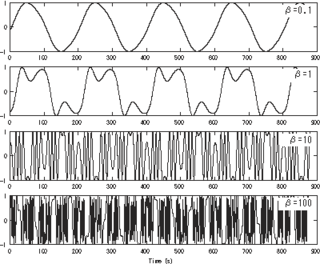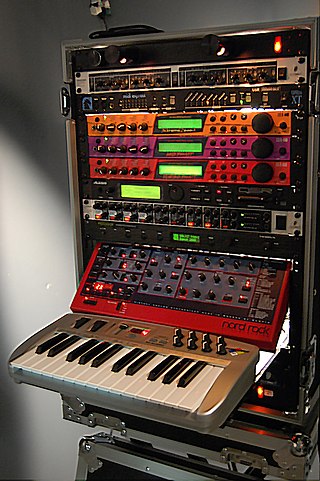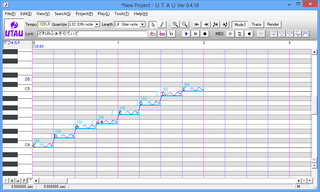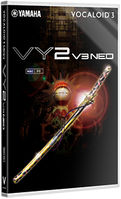Related Research Articles
Electronic music is a genre of music that employs electronic musical instruments, digital instruments, or circuitry-based music technology in its creation. It includes both music made using electronic and electromechanical means. Pure electronic instruments depended entirely on circuitry-based sound generation, for instance using devices such as an electronic oscillator, theremin, or synthesizer. Electromechanical instruments can have mechanical parts such as strings, hammers, and electric elements including magnetic pickups, power amplifiers and loudspeakers. Such electromechanical devices include the telharmonium, Hammond organ, electric piano and the electric guitar.

Frequency modulation synthesis is a form of sound synthesis whereby the frequency of a waveform is changed by modulating its frequency with a modulator. The (instantaneous) frequency of an oscillator is altered in accordance with the amplitude of a modulating signal.

MIDI is a technical standard that describes a communication protocol, digital interface, and electrical connectors that connect a wide variety of electronic musical instruments, computers, and related audio devices for playing, editing, and recording music.

The Synclavier is an early digital synthesizer, polyphonic digital sampling system, and music workstation manufactured by New England Digital Corporation of Norwich, Vermont. It was produced in various forms from the late 1970s into the early 1990s. The instrument has been used by prominent musicians.

Digital music technology encompasses digital instruments, computers, electronic effects units, software, or digital audio equipment by a performer, composer, sound engineer, DJ, or record producer to produce, perform or record music. The term refers to electronic devices, instruments, computer hardware, and software used in performance, playback, recording, composition, mixing, analysis, and editing of music.

Yamaha Corporation is a Japanese musical instrument and audio equipment manufacturer.

Vocaloid is a singing voice synthesizer software product. Its signal processing part was developed through a joint research project led by Kenmochi Hideki at the Pompeu Fabra University in Barcelona, Spain, in 2000 and was not originally intended to be a full commercial project. Backed by the Yamaha Corporation, it developed the software into the commercial product "Vocaloid" that was released in 2004.

Hatsune Miku, officially code-named CV01, is a Vocaloid software voicebank developed by Crypton Future Media and its official anthropomorphic mascot character, a 16-year-old girl with long, turquoise twintails. Miku's personification has been marketed as a virtual idol, and has performed at live virtual concerts onstage as an animated projection.

Megurine Luka, codenamed "CV03", is a Vocaloid software developed by Crypton Future Media, headquartered in Sapporo, Japan. Its official moe anthropomorphism is a 20-year-old woman. She uses Yamaha Corporation's Vocaloid 2 and Vocaloid 4 singing synthesizer technology. Her voice is sampled from Yū Asakawa. She has performed alongside other Vocaloids at live concerts onstage as an animated hologram projection.
Crypton Future Media, Inc., or simply Crypton, is a Japanese media company based in Sapporo, Japan. It develops, imports, and sells products for music, such as sound generator software, sampling CDs and DVDs, and sound effect and background music libraries. The company also provides services of online shopping, online community, and mobile content.

UTAU is a Japanese singing synthesizer application created by Ameya/Ayame (飴屋/菖蒲). This program is similar to the VOCALOID software, with the difference being it is shareware instead of under a third party licensing.

Internet Co., Ltd. or Internet, is a software company based in Osaka, Japan. It is best known for the music sequencer Singer Song Writer and Niconico Movie Maker for Nico Nico Douga, a video sharing website. It also develops singing synthesizers using the Vocaloid 4 engine developed by Yamaha Corporation. In 2014, they were the second leading company in sound-related software in Japan, boasting a 14.0% share of the market.

PowerFX Systems AB, commonly referred to simply as PowerFX, is a small recording company, based in Stockholm, Sweden. The company has been producing music samples, loops and sound effects since 1995. They also developed singing synthesizers using the VOCALOID engine developed by Yamaha Corporation.
Zero-G is a British company that develops sound libraries, sound effects and audio loops. It also develops "singing" synthesisers using the Vocaloid engine developed by Yamaha Corporation.
Vocaloid is a singing voice synthesizer and the first engine released in the Vocaloid series. It was succeeded by Vocaloid 2. This version was made to be able to sing both English and Japanese.

Vocaloid 2 is a singing voice synthesizer and the successor to the Vocaloid voice synthesizer application by Yamaha. Unlike the first engine, Vocaloid 2 based its output on vocal samples, rather than voice analysis. The synthesis engine and the user interface were completely revamped, with Japanese Vocaloids possessing a Japanese interface, as opposed to the previous version, which used English for both versions. It is noteworthy for introducing the popular character Hatsune Miku. It was succeeded by Vocaloid 3.

Vocaloid 3 is a singing voice synthesizer and successor to Vocaloid 2 in the Vocaloid series. This version of the software is a much more expansive version, containing many new features, three new languages and many more vocals than past software versions combined. It was succeeded by Vocaloid 4.

VY2 is a Japanese masculine vocal developed by Yamaha Corporation and distributed by Bplats, Inc. to act as a "standard" vocal for Vocaloid. It has the codename of "Yūma". It was originally released for the Vocaloid 2 engine. The fan design "Roro" which is illustrated by song producer Manbou no Ane, is commonly used to represent VY2. VY2 also has a Falsetto Voicebank that allows users to make higher pitched songs with its voice. VY2's voice bank is often used with the VY1 voice bank.

ZOLA Project is a release package for the Vocaloid 3 software containing the voices of 3 male singers. "ZOLA" is an acronym for "Zenithal Operated Liaison Aggregation".
References
- 1 2 Power, Melanie (July 15, 2011). "When Lola became Ana – How Zero-G's Vocaloid Created a Lead Singer…". Time+Space blog. Archived from the original on July 12, 2012. Retrieved January 1, 2013.
- 1 2 3 Staff (n.d.). "anaROBIK Biography". anarobik.com. Archived from the original on January 16, 2013. Retrieved January 1, 2012.